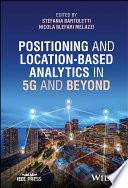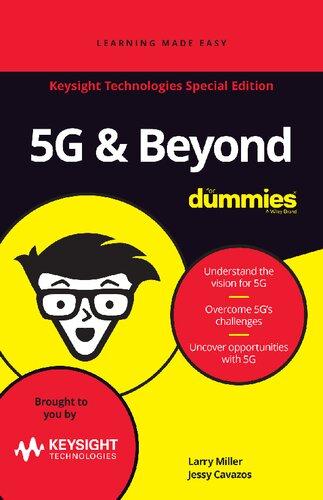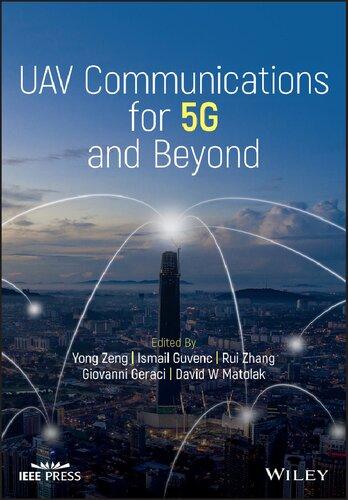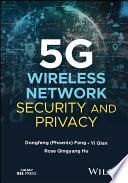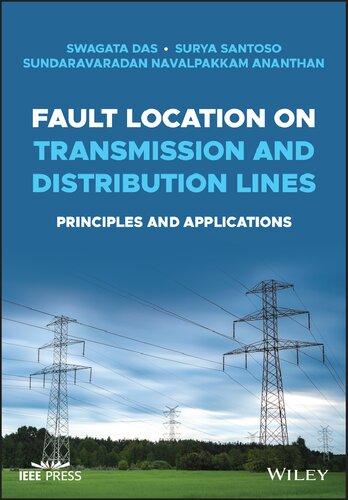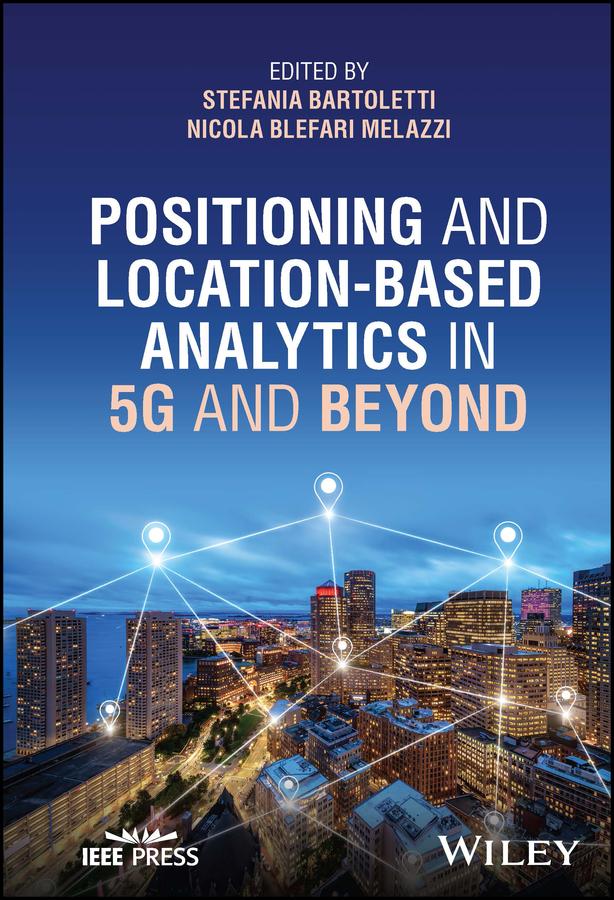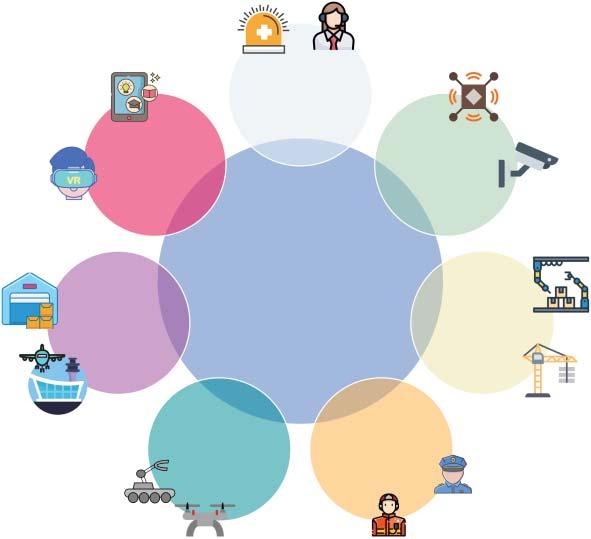PositioningandLocation-basedAnalyticsin 5GandBeyond
Editedby StefaniaBartolettiandNicolaBlefariMelazzi
UniversityofRomeTorVergataandCNIT,Italy
Copyright©2024byTheInstituteofElectricalandElectronicsEngineers,Inc. Allrightsreserved.
PublishedbyJohnWiley&Sons,Inc.,Hoboken,NewJersey.
PublishedsimultaneouslyinCanada.
Nopartofthispublicationmaybereproduced,storedinaretrievalsystem,ortransmittedinany formorbyanymeans,electronic,mechanical,photocopying,recording,scanning,orotherwise, exceptaspermittedunderSection107or108ofthe1976UnitedStatesCopyrightAct,without eitherthepriorwrittenpermissionofthePublisher,orauthorizationthroughpaymentofthe appropriateper-copyfeetotheCopyrightClearanceCenter,Inc.,222RosewoodDrive,Danvers, MA01923,(978)750-8400,fax(978)750-4470,oronthewebatwww.copyright.com.Requeststo thePublisherforpermissionshouldbeaddressedtothePermissionsDepartment,JohnWiley& Sons,Inc.,111RiverStreet,Hoboken,NJ07030,(201)748-6011,fax(201)748-6008,oronlineat http://www.wiley.com/go/permission.
Trademarks:WileyandtheWileylogoaretrademarksorregisteredtrademarksofJohnWiley& Sons,Inc.and/oritsaffiliatesintheUnitedStatesandothercountriesandmaynotbeused withoutwrittenpermission.Allothertrademarksarethepropertyoftheirrespectiveowners. JohnWiley&Sons,Inc.isnotassociatedwithanyproductorvendormentionedinthisbook.
LimitofLiability/DisclaimerofWarranty:Whilethepublisherandauthorhaveusedtheirbest effortsinpreparingthisbook,theymakenorepresentationsorwarrantieswithrespecttothe accuracyorcompletenessofthecontentsofthisbookandspecificallydisclaimanyimplied warrantiesofmerchantabilityorfitnessforaparticularpurpose.Nowarrantymaybecreatedor extendedbysalesrepresentativesorwrittensalesmaterials.Theadviceandstrategiescontained hereinmaynotbesuitableforyoursituation.Youshouldconsultwithaprofessionalwhere appropriate.Neitherthepublishernorauthorshallbeliableforanylossofprofitoranyother commercialdamages,includingbutnotlimitedtospecial,incidental,consequential,orother damages.Further,readersshouldbeawarethatwebsiteslistedinthisworkmayhavechanged ordisappearedbetweenwhenthisworkwaswrittenandwhenitisread.Neitherthepublisher norauthorsshallbeliableforanylossofprofitoranyothercommercialdamages,includingbut notlimitedtospecial,incidental,consequential,orotherdamages.
Forgeneralinformationonourotherproductsandservicesorfortechnicalsupport,please contactourCustomerCareDepartmentwithintheUnitedStatesat(800)762-2974,outsidethe UnitedStatesat(317)572-3993orfax(317)572-4002.
Wileyalsopublishesitsbooksinavarietyofelectronicformats.Somecontentthatappearsin printmaynotbeavailableinelectronicformats.FormoreinformationaboutWileyproducts, visitourwebsiteatwww.wiley.com.
LibraryofCongressCataloging-in-PublicationDataAppliedfor: Hardback:9781119911432
CoverDesign:Wiley CoverImage:©Prasitphoto/GettyImages
Setin9.5/12.5ptSTIXTwoTextbyStraive,Chennai,India
Contents
AbouttheEditors xii
ListofContributors xiii
Preface xiv
Acknowledgments xx
ListofAbbreviations xxi
1IntroductionandFundamentals 1
StefaniaBartoletti,EduardoBaena,RaquelBarco,GiacomoBernini, NicolaBlefariMelazzi,HuiChen,SergioFortes,DomenicoGiustiniano, MythriHunukumbure,FanJiang,EmilJ.Khatib,OluwatayoKolawole, AristotelisMargaris,SaraModarresRazavi,AthinaRopodi,GürkanSolmaz, KostasTsagkaris,andHenkWymeersch
1.1IntroductionandMotivation 1
1.2UseCases,Verticals,andApplications 2
1.2.1EmergencyCalls 2
1.2.2PublicSafetyandNaturalDisasters 3
1.2.3ITSandAutonomousVehicles 4
1.2.4IIoT,ConstructionSites,andMines 4
1.2.5CommercialandTransportHubs 5
1.2.6Internet-of-Things 5
1.2.7EducationandGaming 6
1.3FundamentalsofPositioningandNavigation 7
1.3.1Position-DependentMeasurements 7
1.3.2PositioningMethods 8
1.3.3AI/MLforPositioning 9
1.4FundamentalsofLocation-BasedAnalytics 10
1.5IntroductiontoArchitecturalPrinciples 12
1.5.15GArchitectureandPositioning 13
1.5.2Location-BasedAnalyticsPlatform 13
1.6BookOutline 16
References 17
PartIPositioningEnablers 19
2PositioningMethods 21
StefaniaBartoletti,CarlosS.Álvarez-Merino,RaquelBarco,HuiChen, AndreaConti,YannisFilippas,DomenicoGiustiniano,CarlosA.GómezVega, MythriHunukumbure,FanJiang,EmilJ.Khatib,OluwatayoY.Kolawole, FlavioMorselli,SaraModarresRazavi,AthinaRopodi,JoergWidmer,MoeZ. Win,andHenkWymeersch
2.1PositioningasParameterEstimation 22
2.1.1TheSnapshotPositioningProblem 22
2.1.2FisherInformationandBounds 24
2.1.3TrackingandLocation-DataFusion 25
2.1.3.1PracticalAspects 27
2.2Device-BasedRadioPositioning 28
2.2.1TheoreticalFoundations 28
2.2.1.1SignalModel 28
2.2.1.2EquivalentFisherInformationMatrix 29
2.2.1.3Interpretation 30
2.2.2SignalProcessingTechniques 30
2.2.3ExampleResultsof5G-BasedPositioninginIIoTScenarios 31
2.3Device-FreeRadioLocalization 33
2.3.1TheoreticalFoundations 34
2.3.1.1SignalModel 34
2.3.1.2EFIMforDFL 35
2.3.1.3Interpretation 36
2.3.2SignalProcessingTechniques 37
2.3.3ExperimentalResultson5G-BasedDFL 38
2.4AI/MLforPositioning 40
2.4.1FingerprintingApproach 41
2.4.2SoftInformation-BasedApproach 44
2.4.3AI/MLtoMitigatePracticalImpairments 46 References 47
3Standardizationin5Gand5GAdvancedPositioning 51 SaraModarresRazavi,MythriHunukumbure,andDomenicoGiustiniano
3.1PositioningStandardizationSupportPriorto5G 51
3.1.1GNSSandReal-TimeKinematics(RTK)GNSSPositioning 52
3.1.2WiFi/Bluetooth-BasedPositioning 55
3.1.3TerrestrialBeaconSystem 56
3.1.4SensorPositioning 56
3.1.5RAT-DependentPositioningPriorto5G 56
3.1.5.1EnhancedCID(eCID) 57
3.1.5.2ObservedTime-Difference-of-Arrival(OTDoA) 58
3.1.5.3UplinkTime-Difference-of-Arrival(UTDoA) 58
3.1.6InternetofThings(IoT)Positioning 58
3.1.7OtherNon-3GPPTechnologies 58
3.1.7.1UWB 58
3.1.7.2Fingerprinting 59
3.25GPositioning 59
3.2.15GLocalizationArchitecture 60
3.2.2PositioningProtocols 62
3.2.3RAT-DependentNRPositioningTechnologies 64
3.2.3.1Downlink-BasedSolutions 64
3.2.3.2Uplink-BasedSolutions 64
3.2.3.3Downlink-andUplink-BasedSolutions 64
3.2.4SpecificPositioningSignals 65
3.2.4.1DownlinkPositioningReferenceSignal 66
3.2.4.2UplinkSignalforPositioning 67
3.2.5PositioningMeasurements 68
3.3HybridPositioningTechnologies 69
3.3.1OutdoorFusion 69
3.3.2IndoorFusion 70
3.45GAdvancedPositioning 71 References 72
4EnablersToward6GPositioningandSensing 75 JoergWidmer,HenkWymeersch,StefaniaBartoletti,HuiChen,Andrea Conti,NicolòDecarli,FanJiang,BarbaraM.Masini,FlavioMorselli, GianlucaTorsoli,andMoeZ.Win
4.1IntegratedSensingandCommunication 76
4.1.1ISACApplication:JointRadarandCommunicationwithSidelink V2X 77
4.1.1.1V2XandItsSensingPotential 79
4.1.1.2V2XTargetParameterEstimationandSignalNumerology 80
4.1.1.3V2XResourceAllocation 81
4.1.2ISACApplication:HumanActivityRecognitionandPerson Identification 82
4.1.2.1BeyondPositioning 82
4.1.2.2SystemAspects 83
4.1.2.3ProcessingChain 83
4.2ReconfigurableIntelligentSurfacesforPositioningandSensing 85
4.2.1RISEnablingandEnhancingPositioning 86
4.2.1.1RISEnablingPositioning 87
4.2.1.2RISEnhancingPositioning 87
4.2.1.3UseCases 88
4.2.2RISforSensing 88
4.3AdvancedMethods 90
4.3.1Model-BasedMethods 90
4.3.2AI-BasedMethods 92
4.3.2.1UseCase 93 References 93
5Security,Integrity,andPrivacyAspects 99
StefaniaBartoletti,GiuseppeBianchi,NicolaBlefariMelazzi,Domenico Garlisi,DaniloOrlando,IvanPalamá,andSaraModarresRazavi
5.1LocationPrivacy 100
5.1.1OverviewonthePrivacyImplication 100
5.1.2IdentificationandAuthenticationinCellularNetworks 102
5.1.3IMSICatchingAttack 103
5.1.4EnhancedPrivacyProtectionin5GNetworks 104
5.1.5LocationPrivacyAlgorithms 106
5.1.6LocationPrivacyConsideredModel 108
5.1.7LocationPrivacyTestedApproach 108
5.2LocationSecurity 110
5.2.1LocationSecurityin4G/5GNetworks 112
5.2.2ThreatModelsandBounds 113
5.2.2.1FormalModel 114
5.2.2.2ErrorModelfortheSpoofingAttack 115
5.2.2.3ThreatModelExampleCaseStudy:Range-BasedLocalization UsingRSSI 116
5.2.2.4ErrorBoundUnderSpoofingAttack 116
5.2.2.5CaseStudy 117
5.33GPPIntegritySupport 119 References 121
PartIILocation-basedAnalyticsandNewServices 125
6LocationandAnalyticsforVerticals 127
GürkanSolmaz,RaquelBarco,StefaniaBartoletti,AndreaConti,Nicolò Decarli,YannisFilippas,AndreaGiani,EmilJ.Khatib,OluwatayoY. Kolawole,TomaszMach,BarbaraM.Masini,andAthinaRopodi
6.1People-CentricAnalytics 127
6.1.1CrowdMobilityAnalytics 127
6.1.1.1IntroductionandRelatedWork 127
6.1.1.2ExampleExperimentalResultsfromCrowdMobilityAnalytics:Group Inference 133
6.1.2FlowMonitoring 135
6.1.2.1IntroductionandRelatedWork 135
6.1.2.2SelectedDLApproachesandResultsforTrajectoryPrediction 136
6.1.3COVID—19ContactTracing 139
6.1.3.1IntroductionandRelatedWork 139
6.1.3.2SelectedApproachandExampleResultsfromContactTracing 141
6.2LocalizationinRoadSafetyApplications 142
6.2.1Safety-CriticalUseCasesand5GPosition-RelatedRequirements 143
6.2.1.1IntroductionandRelatedWork 143
6.2.1.2ExampleResultsforSafety-CriticalUseCases 144
6.2.2UpperLayersArchitectureinETSIITSStandard 145
6.2.2.1IntroductionandRelatedWork 145
6.2.2.2ExampleResultsforITS 148
6.2.35GAutomotiveAssociation(5GAA)Activities 151 References 152
7Location-AwareNetworkManagement 157 SergioFortes,EduardoBaena,RaquelBarco,IsabeldelaBandera, ZwiAltman,LucaChiaraviglio,WassimB.Chikha,SanaB.Jemaa, YannisFilippas,ImedHadj-Kacem,AristotelisMargaris,MarieMasson, andKostasTsagkaris
7.1Introduction 157
7.2Location-AwareCellularNetworkPlanning 161
7.2.1WhatIstheCellularNetworkPlanning? 161
7.2.2WhyIsLocalizationImportantinthePlanningPhase? 162
7.2.3Location-AwareCellularNetworkPlanning 164
7.2.4FutureDirections 164
7.3Location-AwareNetworkOptimization 165
7.3.1WhatIstheCellularNetworkOptimization? 165
7.3.2WhyIsLocationInformationImportantinOptimization? 166
7.3.3HybridClustering-BasedOptimizationof5GMobileNetworks 167
7.3.3.1ClusteringMethodsandAlgorithmicApproach 167
7.3.3.2ResultsandConclusions 168
7.3.4Location-AwareCapacityandCoverageOptimization 170
7.3.4.1Dual-ConnectivityOptimization 170
7.3.4.2ResultsandConclusions 171
7.3.5SINRPredictioninPresenceofCorrelatedShadowinginCellular Networks 172
7.3.5.1SINRPredictionwithKriging 173
7.3.5.2ResultsandConclusions 175
7.3.5.3Multi-user(MU)SchedulingEnhancementwithGeolocation InformationandRadioEnvironmentMaps(REMs) 177
7.3.5.4ResultsandConclusions 178
7.3.6Social-AwareLoadBalancingSystemforCrowdsinCellular Networks 179
7.3.6.1Social-AwareFuzzyLogicController(FLC)PowerTrafficSharing(PTS) Control 179
7.3.6.2ResultsandConclusions 180
7.3.7FutureDirections 182
x Contents
7.4Location-AwareNetworkFailureManagement 182
7.4.1WhatIstheCellularNetworkFailureManagement? 182
7.4.2WhyIsLocalizationImportantinFailureManagement? 183
7.4.3ContextualizedIndicators 184
7.4.3.1ContextualizedIndicators 184
7.4.3.2ResultsandConclusions 186
7.4.4Location-BasedDeepLearningTechniquesforNetworkAnalysis 189
7.4.4.1SyntheticmagesandDeep-LearningClassification 189
7.4.4.2ResultsandConclusions 190 References 193
PartIIIArchitecturalAspectsforLocalizationand
Analytics 197
8Location-BasedAnalyticsasaService 199 AthinaRopodi,GiacomoBernini,AristotelisMargaris,andKostasTsagkaris
8.1MotivationforaDedicatedPlatform 199
8.2Principles 201
8.2.1MicroserviceArchitecturalApproach 201
8.2.2SoftwareContainerization 203
8.2.3MixedKappaandLambdaDataLakeApproach 203
8.2.4DesigninganML-andAI-AwareSolution 204
8.2.5AbstractingComputationOptimizationProcesses 204
8.2.6AutomatingDependencyResolutionandLinking 205
8.2.7AchievingLowLatencyEnd-to-End 205
8.2.8DecouplingProcessingandAPIAccess 205
8.2.9OfferingDynamicResourceAllocation 206
8.2.10DecouplingServicesandSecurity 206
8.3PlatformSystemOverview 206
8.4PlatformSystemBlocksDescription 209
8.4.1APIBlocks 209
8.4.2ControlBlocks 210
8.4.3CoreBlocks 212
8.4.4VirtualizationManagementandInfrastructureBlocks 214
8.5FunctionalDecomposition 214
8.5.1DataCollectionFunctions 215
8.5.2PersistenceandMessageQueueFunctions 216
8.5.3PositioningandAnalyticsFunctions 218
8.5.3.1PositioningFunctions 218
8.5.3.2AnalyticsFunctions 218
8.5.4SecurityandPrivacyFunctions 219
8.5.4.1SecurityFunctions 219
8.5.4.2PrivacyFunctions 221
8.5.5AnalyticsAPIFunctions 221
8.5.6ControlFunctions 221
8.5.7Management,Orchestration,andVirtualizationFunctions 222
8.6SystemWorkflowsandDataSchemaAnalysis 224
8.6.1SystemWorkflows 224
8.6.1.1ServiceActivation 224
8.6.1.2ServiceConsumption 226
8.6.1.3SouthboundDataCollection 226
8.6.1.4PositioningandAnalyticsServiceOperation 228
8.6.2ApplicableDataSchema 231
8.6.2.1GeoJSONDataFormat 231
8.6.2.2JSONSQLTableSchemaFormat 231
8.6.2.33GPPLocationInputData 232
8.7PlatformImplementation:AvailableTechnologies 232
8.7.1AccessControlModule 234
8.7.2ServiceDiscoveryModule 234
8.7.3APIGatewayandServiceSubscriptionModule 234
8.7.4DataOperationsController 234
8.7.5MLPipelineController 235
8.7.6MLModelRepository 235
8.7.7DataCollectionModule 235
8.7.8DataPersistenceModule 235
8.7.9MessageQueue 236
8.7.10Virtualizationlayer 236
8.7.11ManagementandOrchestration 237 References 237
9ReferenceStandardArchitectures 239 GiacomoBernini,AristotelisMargaris,AthinaRopodi,andKostasTsagkaris
9.1DataAnalyticsinthe3GPPArchitecture 239
9.1.1EvolvedNetworkDataAnalyticsin3GPPR17 240
9.1.2MappingwithLocationDataAnalytics 244
9.23GPPCAPIF 245
9.33GPPSEAL 246
9.4ETSINFV 248
9.4.1MappingwithLocationAnalyticsFunctionsManagement 250
9.5ETSIZeroTouchNetworkandServiceManagement(ZSM) 250
9.5.1MappingwithLocationAnalyticsServicesManagement 251 References 253
Index 255
AbouttheEditors
StefaniaBartoletti,PhD,isanassistantprofessorattheUniversityofRome TorVergata,Italy,andamemberoftheNationalInter-UniversityConsortium forTelecommunications(CNIT).Shehasreceivedresearchfundingfromthe EuropeanCommissionthroughanERCStartingGrant,asMarie-Skłodowska CurieGlobalFellow,andascoordinatoroftheprojectLOCUS.
NicolaBlefariMelazzi,PhD,isaprofessorattheUniversityofRomeTorVergata, Italy;PresidentoftheNationalInter-UniversityConsortiumforTelecommunications(CNIT);andPresidentoftheRESTARTFoundation.Hehasreceivedresearch fundingfromItalianMinistries,world-leadingtelecommunicationscompanies, andtheEuropeanCommissionascoordinatorofsevenEuropeanprojects.Hehas beenappointedbytheItalianMinistryofResearchastheItalianrepresentativeto theEuropeanSmartNetworksandServicesJointUndertaking.
ListofContributors
ZwiAltman
OrangeLabs
Châtillon
France
CarlosS.Álvarez-Merino
TelecommunicationResearchInstitute (TELMA)
UniversityofMalaga
E.T.S.I.deTelecomunicación
Málaga Spain
EduardoBaena
TelecommunicationResearchInstitute (TELMA)
UniversityofMalaga
E.T.S.I.deTelecomunicación
Málaga Spain and
TelecommunicationResearchInstitute (TELMA) UniversidaddeMálaga Málaga
Spain
RaquelBarco TelecommunicationResearchInstitute (TELMA)
UniversityofMalaga
E.T.S.I.deTelecomunicación
Málaga
Spain
StefaniaBartoletti DepartmentofElectronicEngineering andCNIT
UniversityofRomeTorVergata
Rome
Italy
GiacomoBernini
Nextworks
Pisa
Italy
GiuseppeBianchi DepartmentofElectronicEngineering andCNIT
UniversityofRomeTorVergata
Rome
Italy
HuiChen DepartmentofElectricalEngineering ChalmersUniversityofTechnology
Gothenburg
Sweden
LucaChiaraviglio DepartmentofElectronicEngineering andCNIT
UniversityofRomeTorVergata
Rome
Italy
xiv ListofContributors
WassimB.Chikha OrangeLabs Châtillon
France
AndreaConti DepartmentofEngineeringandCNIT UniversityofFerrara Ferrara
Italy
IsabeldelaBandera TelecommunicationResearchInstitute (TELMA) UniversityofMalaga
E.T.S.I.deTelecomunicación Málaga
Spain
NicolòDecarli NationalResearchCouncil–Instituteof Electronics ComputerandTelecommunication EngineeringandWiLab-CNIT Bologna
Italy
YannisFilippas IncelligentP.C.
Athens
Greece
SergioFortes TelecommunicationResearchInstitute (TELMA)
UniversityofMalaga
E.T.S.I.deTelecomunicación Málaga
Spain
DomenicoGarlisi DepartmentofMathematicsand ComputerScienceandCNIT UniversityofPalermo Palermo
Italy
AndreaGiani DepartmentofEngineeringandCNIT UniversityofFerrara
Ferrara
Italy
DomenicoGiustiniano IMDEANetworksInstitute
Madrid
Spain
CarlosA.GómezVega DepartmentofEngineeringandCNIT UniversityofFerrara
Ferrara
Italy
ImedHadj-Kacem OrangeLabs
Châtillon
France
MythriHunukumbure CommunicationsResearch SamsungElectronicsR&DInstituteUK Staines-upon-Thames
England
UnitedKingdom
SanaB.Jemaa OrangeLabs
Châtillon
France
FanJiang DepartmentofElectricalEngineering ChalmersUniversityofTechnology
Gothenburg
Sweden
EmilJ.Khatib TelecommunicationResearchInstitute (TELMA)
UniversityofMalaga
E.T.S.I.deTelecomunicación
Málaga
Spain
OluwatayoY.Kolawole CommunicationsResearch
SamsungElectronicsR&DInstituteUK Staines-upon-Thames England UnitedKingdom TomaszMach CommunicationsResearch
SamsungElectronicsR&DInstituteUK Staines-upon-Thames England UnitedKingdom
AristotelisMargaris IncelligentP.C. Athens Greece
BarbaraM.Masini
NationalResearchCouncil–Instituteof Electronics ComputerandTelecommunication EngineeringandWiLab-CNIT Bologna
Italy
MarieMasson OrangeLabs Châtillon
France
NicolaBlefariMelazzi DepartmentofElectronicEngineering andCNIT UniversityofRomeTorVergata
Rome
Italy
FlavioMorselli DepartmentofEngineeringandCNIT UniversityofFerrara Ferrara
Italy
DaniloOrlando University“NiccolòCusano”
Rome
Italy
IvanPalamà DepartmentofElectronicEngineering andCNIT UniversityofRomeTorVergata
Rome
Italy
SaraModarresRazavi EricssonResearch EricssonAB
Stockholm
Sweden
AthinaRopodi IncelligentP.C.
Athens
Greece
GurkanSolmaz NECLaboratoriesEurope Heidelberg
Germany
GianlucaTorsoli DepartmentofEngineeringandCNIT UniversityofFerrara Ferrara
Italy
KostasTsagkaris IncelligentP.C.
Athens
Greece
JoergWidmer IMDEANetworksInstitute
Madrid
Spain
MoeZ.Win LaboratoryforInformationandDecision Systems(LIDS) MassachusettsInstituteofTechnology
Cambridge MA
USA
HenkWymeersch DepartmentofElectricalEngineering ChalmersUniversityofTechnology
Gothenburg
Sweden
Preface
Ubiquitous5GrolloutisamainpriorityforEurope,asittheconnectivitybasisfor thedigitalandgreentransformationofoureconomy.
Earlyreflectionabouttheevolutionofmobilecommunicationnetworks“beyond4G”startedsoonafterthefirstdeploymentofa4Gcommercialnetworkin Swedenin2010.Inthosedays,itwasalreadyapparentthattheveryfastgrowth ofmobiletraffic,between50%and100%increaseonayearlybasis,aswellasthe prospectstoserveinnovativeInternetofThings(IoT)applicationswoulddrive furtherR&Dinthemobilecommunicationdomain.
Takingnoteofthesedevelopments,theEuropeanCommission1 initiatedvisionaryEU-fundedresearchactivitiesalreadyin2012.Thiseventuallyledtothesetup oftheEuropean5GPublicPrivatePartnership(5GPPP).The5GPPPimplemented undertheEuropeanHorizon2020programmewithabout€700Millionofpublic supportoverthe2014–2020period,thelargest5GR&Dinitiativeintheworld.
Theseinitiativesmaterializetheimportanceof5GnetworksforEurope.They areconsideredbytheEuropeanCommissionasastrategicassetforthedigital societyandtosupportthedigitaltransformationoftheindustryandthepublic sector.2
The5GPPPWhitePaperdescribinga“EuropeanVisionforthe6GNetwork Ecosystem”3 highlightedthat“6Gisexpectedtoplayakeyroleintheevolution ofthesocietytowardsthe2030s,astheconvergencebetweenthedigital,physical andpersonalworldswillincreasinglybecomeareality.”
TheWhitePaperrecommendedpublicandprivateR&Iinvestmenttofocuson key6Gtechnologies,“suchasprogrammability,integratedsensingandcommunication,trustworthyinfrastructure,scalabilityandaffordability,aswellasAI/ML,
1Theviewsexpressedinthisarticlearethoseoftheauthorsandshallnotbeconsideredas officialstatementsoftheEuropeanCommission.
2BARANIB.&STUCKMANNP.;Leading-edge5GResearchandInnovation:Anundivided commitmentofEurope,5GinItalyWhiteBook.
3https://5g-ppp.eu/european-vision-for-the-6g-network-ecosystem/.
microelectronics(atleastindesign),photonics,batteries(e.g.,formobiledevices), software,andothertechnologiesthatmayhelptoreducetheenergyfootprint.”
AddressingtheWhitePaper’srecommendations,theCommissionwithEU industrysetupforHorizonEurope,thenewFrameworkProgrammethatstarted 2021,aJointUndertakingonSmartNetworksandServices,beyond5Gand toward6G,inordertomaintainEurope’stechnologyleadershipandensureits technologicalsovereigntyinthelongerterm.TheSmartNetworksandServices JointUndertakingaimstofosterEuropeantechnologicalcapacitiesasregards smartnetworksandservicesvaluechains.Inthiscontext,theaimistoenable EuropeanplayerstodeveloptheR&Icapacitiesfor6Gtechnologiesasabasis forfuturedigitalservicesintheperiodto2030.Theinitiativealsoaimstofoster thedevelopmentofleadmarketsfor5GinfrastructureandservicesinEurope. Bothsetsofactivities(for5Ginfrastructuredeploymentand6GR&I)willfoster thealignmentoffuturesmartnetworksandserviceswithEUpolicyandsocietal needs,includingcompetitiveness,robustsupplychains,energyefficiency,privacy, ethics,andcybersecurity.4
Inaddition,thePathtotheDigitalDecade5 recognizesthatasustainabledigital infrastructureforconnectivityis“anessentialenablerfortakingadvantageofthe benefitsofdigitisation,forfurthertechnologicaldevelopmentsandforEurope’s digitalleadership.”It,therefore,aimstoachieveallpopulatedareascoveredby 5Gby2030.TheSNSJUisexpectedtohelpleadmarketsfor5Ginfrastructureand servicestodevelopinEurope.
Globalstandardizationandspectrumharmonizationareimportantsuccess factorsfor6GtechnologyandfocusofSNS.Bothfutureusersandsuppliers needtoshapekeytechnologystandardsinthefieldofradiocommunications basedonexistingandfuturespectrumbandsforwirelessbroadband,butalso innext-generationnetworkarchitecturetoensurethedeliveryofadvanced servicefeatures,e.g.throughtheeffectiveuseofsoftwaretechnologiesandopen interfaces,whilemeetingenergy-efficiencyrequirements.
For6G,asisalreadythecasewith5G,theEuropeanCommissionsupportsthe emergenceofasinglecomprehensivestandardensuringinteroperability,cybersecurity,andthenecessaryeconomiesofscaleinanareawhereR&Dinvestmentsare massive.Whilethe5Gstandardizationprocessisstillongoing,ithasbeenassessed thatseveralhundredsofindustrycontributionsto3GPPoriginatefromresultsof projectssupportedunderthe5GPPPinitiative,notablyforwhatconcerns(i)the RadioAccessNetworkarchitecture(RAN)and(ii)theservice-orientedarchitectureofthenewcorenetwork.
46GSNSDraftWORKPROGRAMME2023. 5COM(2021)574final.
For6G,theWorkProgrammeoftheSNSJUspecificallyincludesactivities designedtosupportthe6Gstandardizationphase(target2025withfirstbatchof 6GStudyItems).
FromaEuropeanperspective,itisimportanttocontinuetofollowcloselyand supportthe5G/6GstandardizationprocesssothatEUpoliciesaretakeninto account,maintainingstrongpresenceofEuropeanstakeholdersenlargingitto newparticipants,notablyfromtheverticals,thataretodaylittlepresentin3GPP debates.Aninclusivestandardizationprocessisindeedaprerequisiteforaglobal approachtostandardscopingwithacertaindivergenceofmarketneedsinthe differentregions.Toseizethestrategicopportunitiesforthestrongindustrial sectorsinEurope,thestandardizationagendaneedstoaddressfurtherimportant usecasesotherthanhighercapacityanddatarates.6
TheCommissionhasbeenurgingthestandardizationbodies,notablythe3GPP, andtheconcernedindustrialactorstostep-uptheireffortsfortherapiddevelopmentof5Gstandardsaddressingmoreimmediatemarketneeds,whiledrivinga clearstrategyfora5Gglobalstandard.InlinewiththeEUstrategytargeting5G developmentsinsupportof“vertical”industriesandthewiderobjectivesofdigitizingtheEuropeanindustry,benefitsareexpectedtoawiderangeofindustrial usecases.
SeveralofthefeaturesinRelease17areintendedtoenhancenetworkperformanceforexistingservicesandusecases,whileothersaddressnewusecasesand deploymentoptions.5GAdvancedwillbuildonRelease17,providingintelligent networksolutionsandcoveringnumerousnewusecasesinadditiontopreviously definedusecasesanddeploymentoptions.
NewRadiohassupportedpositioningsinceRelease15throughtheuseof LTEpositioning(fornon-standalonedeployments)andradio-accesstechnology independentpositioning(Bluetooth,wirelessLAN,pressuresensors,andsoon). Release16introducedtime-basedpositioningmethodsforNRstandalonedeployments(multi-round-triptime(RTT),DownlinkandUplinkTimeDifferenceof Arrival),aswellasanangle-of-arrivalandangle-of-departure-basedpositioning measurements,whichcanbeusedincombinationwithtiming-basedsolutionsto achievehigheraccuracy.
InRelease-17,NRpositioningisfurtherimprovedforspecificusecasessuch asfactoryautomationbytargeting20–30cmlocationaccuracyforcertaindeployments.Release-17alsointroducesfurtherenhancementstolatencyreductionto enablepositioningintime-criticalusecasessuchasremote-controlapplications.7
6KEMOSA.,BARANIB.,andSTUCKMANNP.“5GStandardisation”,EnjeuxnumériquesN.5-mars2019.
7EKUDENE.“5Gevolutiontoward5Gadvanced:Anoverviewof3GPPreleases17and18”, https://www.ericsson.com/en/reports-and-papers/ericsson-technology-review/articles/5gevolution-toward-5g-advanced.
Asidefromhigh-positioningaccuracy,industrialInternetofThings(IIoT)and automotiveusecasesalsodemandintegrityprotectionofthelocationinformation. Fromahigherlayerpointofview,Release-17introduceskeyperformanceindicatorstoindicatethereliability/integrityofthemeasurementreportlimitedtothe globalnavigationsatellitesystem(GNSS)positioningprocedure.
PrecisepositioningisoftenconsideredasaSatellite-basedfeature,withthe popularuseofGPSorGalileosystems.Cellularnetworks,sensors,localor personalareawirelesstechnologies,andevenArtificialintelligence(AI)are complementarytechnologieswhichcanhelpprovidemorerobustandseamless locationawarenessinchallengingenvironmentslikeindoorpositioning.These usecasesaregettingincreasinglyimportant,as5Gintendstosupportdemanding verticalslikemanufacturingprocessesinfactories,wheresub-cmpositioning precisionemergesasanimportantrequirement.Whilepositioningwasnotpart oftheessentialrequirementsfor5GasoutlinedinITUrecommendationM.2083, ithasbecomeanessentialfeaturefor5Glaterreleases,5Gadvanced,and6G.
5Gbreakstechnologybarrierswithkeyinnovationsforprecisepositioning alreadyinthe3GPPRelease16standard,withenhancementsinRelease17and in5GAdvanced.Thewiderbandwidthsin5Gallowforfinertimingresolutions. Timeresolutionisfurtherimprovedbyintegratingmethodsformeasuring,reporting,andcompensatingforprocessingdelaysintotheradioprotocol.Thelarge numberofantennaelementsinmassiveMIMO,formid-bandsandmmWave, generatesnarrowerradiobeamswhichallowforfinerangularresolution.With comprehensiveworkontime,distance,andangularprecision,themostadvanced versionsof5Gwillprovidecm-levelaccuracywhile6Gmaygobelowthat.This willbeverymuchneededtorealizethe6Gvisionwithamassivereal-timetwinningofthephysicalandthedigitalworlds,whichrequiresignificantprogresson twoaspectslessexploredin5G:positioninganddeterministiccommunications.
The5GPPPLOCUS8 projecthasledpioneeringworkinthatdomain,through improvementsofthefunctionalityof5Ginfrastructurestoprovideaccurateand ubiquitouslocationinformationasanetwork-nativeserviceandtoderivecomplexfeaturesandbehavioralpatternsoutofrawlocationandphysicalevents,and exposethemtoapplicationsviasimpleinterfaces.Localization,togetherwithanalytics,andtheircombinedprovision“asaservice”increasetheoverallvalueofthe 5Gecosystem,allowingnetworkoperatorstobettermanagetheirnetworksand expandtherangeofofferedapplicationsandservices.Thishighlyvaluablework hasmuchcontributedtotheproductionofthisbook,andweremainindebted totheauthorsformakingitpossiblethroughtheirundividedcommitmentand dedication.
BernardBaraniandAchilleasKemos EuropeanCommission,DGCONNECT-E1
8https://5g-ppp.eu/locus/.
Acknowledgments
Thisbookwassupported,inpart,bytheLOCUSProjectthroughtheEuropean Union’sHorizon2020ResearchandInnovationProgrammeunderGrant871249. TheauthorswishtothankBernardBaraniandAchilleasKemosfromthe EuropeanCommission,DGCONNECT-E1,fortheirvaluablecontributionsto thisbook.Theirinsightsandexpertisehaveprovidedavaluableperspectiveon thesubjectmatterandhelpedsetthetoneforthebook.
ListofAbbreviations
AcronymsDefinitions
3GPP3rdGenerationPartnershipProject
5GFifth-generation
AIArtificialintelligence
ANNArtificialneuralnetwork
AoAAngle-of-arrival
AoDAngle-of-departure
APIApplicationprogramminginterface
ARAugmentedreality
CAPIFCommonAPIframeworkfor3GPPnorthboundAPIs
ETSIEuropeanTelecommunicationsStandardsInstitute
FCCFederalCommunicationsCommission
GSMGlobalsystemformobilecommunications
IIoTIndustrialInternet-of-Things
IoTInternet-of-Things
ITSIntelligenttransportationsystem
K-NNK-nearestneighbors
KPIKeyperformanceindicator
LTELong-termevolution
LTE-MLong-termevolutionmachine-typecommunication
MLMachinelearning
xxii ListofAbbreviations
AcronymsDefinitions
NB-IoTNarrowbandInternet-of-Things
NWDAFNetworkdataanalyticsfunction
PCAPrincipalcomponentanalysis
RANRadioaccessnetwork
RATRadioaccesstechnology
RSSIReceivedsignalstrengthindicator
SASystemaspects
SDKSoftwaredevelopmentkit
SVMSupportvectormachine
TDoATime-difference-of-arrival
ToFTime-of-flight
TSGTechnicalspecificationgroupservice
UEUserequipment
URLLCUltra-reliablelow-latencycommunications
XRExtendedreality
V2XVehicle-to-everything
IntroductionandFundamentals
StefaniaBartoletti 1 ,EduardoBaena 2 ,RaquelBarco 2 ,GiacomoBernini 3 , NicolaBlefariMelazzi 1 ,HuiChen 4 ,SergioFortes 2 ,DomenicoGiustiniano 5 , MythriHunukumbure 6 ,FanJiang 4 ,EmilJ.Khatib 2 ,OluwatayoKolawole 6 , AristotelisMargaris 7 ,SaraModarresRazavi 8 ,AthinaRopodi 7 ,Gürkan Solmaz 9 ,KostasTsagkaris 7 andHenkWymeersch 4
1 DepartmentofElectronicEngineeringandCNIT,UniversityofRomeTorVergata,Rome,Italy
2 TelecommunicationResearchInstitute(TELMA),UniversityofMalaga,E.T.S.I.deTelecomunicación, Málaga,Spain
3 Nextworks,Pisa,Italy
4 DepartmentofElectricalEngineering,ChalmersUniversityofTechnology,Gothenburg,Sweden
5 IMDEANetworksInstitute,IMDEA,Madrid,Spain
6 CommunicationsResearch,SamsungElectronicsR&DInstituteUK,Staines-upon-Thames,England, UnitedKingdom
7 IncelligentP.C.,Athens,Greece
8 EricssonResearch,EricssonAB,Stockholm,Sweden
9 NECLaboratoriesEurope,Heidelberg,Germany
1.1IntroductionandMotivation
Theever-growingdemandforlocation-andnavigation-basedserviceshasmadeit difficulttoimaginelifewithoutthesupportofpositioningsystems.Thankstothe enhancementsin5Gandotherradioaccesstechnology(RAT)-independenttechnologies,positioningandlocation-basedanalyticsareexpectedtohaveaneven largerimpactonmanysocietyandindustryusecasestodayandinthefuture. Incellularnetworks,positioningwasinitiatedbasedonestimatesofdistance and/ordirectionbetweenbasestationsanddevicesmainlytosupportconnection establishment.Thenetworkmaintainedaverycrudepositionestimateofthemost recentknownpositionofadevicefromglobalsystemformobilecommunication (GSM)[1].Thiswasinordertofulfilltheregulationrequirementsoftheemergencyservices[2].Sincethen,eachgenerationofcellulartechnologyhasimproved thelevelofachievableaccuracyandhenceenablednewapplicationsandusecases. 3GPPdevelopeditsownpositioningmethodsandtherelatedlocalizationarchitecturesinceLTERelease9(in2010).In3GPP,theterm“localization”isrelated
PositioningandLocation-basedAnalyticsin5GandBeyond,FirstEdition. EditedbyStefaniaBartolettiandNicolaBlefariMelazzi.
©2024TheInstituteofElectricalandElectronicsEngineers,Inc.Published2024byJohnWiley&Sons,Inc.
tothearchitecturalandservicedefinitionsintheServiceandSystemAspects(SA) TechnicalSpecificationGroup(TSG),andtheterm‘positioning’isrelatedto themethodsandimplementationdefinitionsintheRadioAccessNetwork (RAN)TSG.
Thisbookwillcoverthefundamentalsofnetworklocalization,userpositioning, andlocation-basedanalyticsandapplicationsinthe5Gecosystemandbeyond. First,wewillexploretheprimaryverticalsandrelevantusecases,definingthe keyperformanceindicators(KPIs)andrequirements,includingthosedefined bythe3rdGenerationPartnershipProject(3GPP).Theprimarytechnologies willbedescribed,andthefoundationsandsignalprocessingapproachesfor accuratelocalizationwillbediscussed.Architecturalprinciplesfortheprovision oflocation-basedanalyticswillbeintroducedandthetwomainclassesofsuch analyticswillbepresented:analyticsfornetworkmanagementandanalytics forverticals.Practicalexamplesofnovelsolutionsandapplicationsleveraging enhancedlocalizationandlocation-basedanalyticswillbeprovidedtogetherwith performanceevaluations.
1.2UseCases,Verticals,andApplications
Thissectionisorganizedasfollows.Itstartselaboratingontheusecasesandapplicationsbenefitingfromlocationinformation,followedbythefundamentalsof positioningandnavigation.Itthenexplainsthefundamentalsoflocation-based analyticsandthearchitecturalprinciplesforthepositioningsolutionsin3GPP andotherglobalinitiatives.
Whilethefirstpositioningusecasewasthelocationofemergencycallsinprior cellulargenerations,currentlytheadvancesinthe5Gnetworkmakeitpossibleto targetaccurateandtimelypositioningforsafety-criticalintelligenttransportsystems(ITS)applications,suchasadvancewarningsystemsandvulnerableroad userprotectionorindustrialinternetofthings(IIoT)scenarios.Moreadvanced technologiessuchaspositioninginextendedreality(XR)usecasescanbeprovisionedwith5G(B5G)and6G.
Asetofkeycategoriesofusecases,verticals,andapplicationsthatwillbenefit frompositioningservicesarerepresentedinFigure1.1.Wecanidentify: emergencies, InternetofThings, IIoT,constructionsitesandmines, Publicsafetyandnatural disasters, ITSandAutonomousVehicles, Commercialandtransporthubs,and EducationandGaming.Thesearedetailedinthenextsections.
1.2.1EmergencyCalls
Themainusecasethatderivedthepositioningstudyin3GPPstandardization wastolocalizeemergencycalls.TheFederalCommunicationCommission(FCC)
Figure1.1 Illustrationofthecategoriesofusecasesforpositioningandlocation-based analytics.
regulatoryrequirementsintheUSmandatedin1996thatbyOctober2001mobile phonescallingtheemergencynumber911hadtobelocalizedwithin100mfor 67%ofcases.In2015,thehorizontalpositioningtargetfortheuserequipment (UE)wassettobelow50mfor80%ofall911callsbyApril2021.Inamorerecent reportfromFCCin2020,thetargetforverticalpositioningaccuracywasalsoset, targetingafloor-levelaccuracyof3minthe80%ofindoorwireless911calls.
1.2.2PublicSafetyandNaturalDisasters
Akeyfactorforsuccessfulemergencyoperationsisreliablecommunicationand real-timeaccesstocriticalinformation.Theabilitytolocatethevictimsisof coursetheprimarygoalofarescueoperation;inaddition,itiscriticaltoaccurately locatefirstrespondersand/ortheequipmentbeingusedthroughoutarescue operation.Indeed,naturaldisastersandemergencyeventscanstartanywhere overlargeareas,andreliableandaccuratefixedpositioninginfrastructureover thewholeareaisoftencostlyandimpractical.Instead,temporaryanddynamic deploymentsforpositioningcanbeasolution.Redundancyinthepositioning
technologyisparticularlyimportantinthesecaseswhere,e.g.satellitesignalscan beobscuredbyvegetationorsmoke.Positioningofpersonnelandotherresources (inbothhorizontalandverticaldimensions)isessentialforanefficientresponse tomanykindsofemergencysituations,includingfloodsandearthquakes.
1.2.3ITSandAutonomousVehicles
Theevolutionofvehicularsystemsismovingtowardevermoreconnected andfullyautomatedvehicles.Suchhighlevelofautonomyleveragestwomain enablers,amongothers:location-awarenessbasedonaccuratepositioningand sensing,andultra-reliablelow-latencycommunication(URLLC)amongvehicles withinasharednetworkinfrastructure[3–7].Thesefunctionalitiesallowvehicles todevelopasharedperceptionoftheirsurroundingsandmakedecisionsbased onlocalviewsandexpectedmaneuversfromnearbyusers.Thecombinationof URLLCwithaccuratepositioningandsensingleadsthewaytowardasafertransportationsystemwiththegoalofachievingzeroroaddeathsandabettertraffic flow.GivensuchunprecedentedcombinationofURLLCandhighlocalization accuracy,5Gisthefirsttechnologythathasthepotentialtomeetsomeofthevery stringentrequirementsofroadsafetyapplications[8].
Besidesaccuracyandlatency,positioningintegrity,i.e.themeasureoftrustthat canbeplacedonthecorrectnessofinformationsuppliedbyapositioningsystem,is requiredforusecasessuchasrailandmaritime,unmannedautonomousvehicles (drones),autonomousdriving,andvehicle-to-everything(V2X)tominimizesafety hazards,accidents,anderroneouslegaldecisionsthatinvolveliabilities.Itisalso essentialforothermission-criticalapplicationswherepositioningerrorscould causeharm,includingemergencyservices,e-health,andmanyIIoTscenarios.
1.2.4IIoT,ConstructionSites,andMines
IIoTusecasesarecharacterizedbyambitioussystemrequirementsforpositioning accuracyinmanyverticals.Forexample,onthefactoryfloor,itisimportant tolocateassetsandmovingobjectssuchasforklifts,orpartstobeassembled. Similarneedsexistintransportationandlogistics,forexample.Thedeployment scenariofordifferentindoorindustrialenvironmentshasasignificantimpact onthepositioningperformanceintermsofbothaccuracyandavailabilityofthe service.Theimpactofthevariousobjectsthatarepresentinafactoryhallisalso implicitlyimpactingthepathlossandmultipathparameters.
Trackingoftoolsandmaterialsonfactories,constructionsites,andotherindustrialscenariosisofinterestforincreasedefficiencyandresourceutilization.Each ofthedifferentscenarioswillimposedifferentconditions,challenges,andrequirements.Forinstance,aconstructionsite,incontrasttoafactory,developsovertime,
andasupportingtelecommunicationinfrastructureisnotalwaysavailablefrom thestart.Amobiledeploymentof,forexample,5Gbasestationsforpositioning canquicklybeputtouseandbeadjustedtochangingneeds.Theconditionsinthe miningindustryaresimilarinmanyrespects:fixedinfrastructuredoesnotoften exist,theenvironmentisconstantlychanging,andthespecificpartsofthemine, whereon-goingworkrequirespositioningservices,varyovertime.
1.2.5CommercialandTransportHubs
Largeandopen-airshoppingmalls,consistingoflargewalkingandcommon areaswithmultipleshopsandestablishments,areagrowingtrendandexpected tobepredominantinthenearfuture.Similarly,transporthubs,suchasairportsor trainstations,alsocommonlyconsistofcommonareastogetherwithindividual shops.Thenetworkservicehereishighlyconditionedbypeople’smobilityand crowdaspectsimpactingtheoptimizationofallnetworkresources,together withcutting-edgeapplicationsandservices.Theuseofultra-densenetworksin suchscenariostogetherwiththedynamicnatureoftheusers’movementmake themaveryhighmobilityscenario,withcontinuousneedforhandoversand loadbalancingadaptationstocoverthedemand.Moreover,thesearehighly denseareasintermsofdevicesandradioequipment,whereanumberofheterogeneousradioaccesstechnologiesareavailabletogetherwithpotentially InternetofThings(IoT)devices.Bothpublicandprivatenetworks(e.g.deployed byshoppingmallsforthecustomerorfortheemployeesandlogistics)may coexist.Multiplecutting-edgeandverynetwork-demandingapplicationsare expected.XRandholographiccommunications,bothforleisureactivitiesin themallaswellaspartoftheshopactivities,marketing,andcustomersupport (e.g.augmentedreality(AR)-supportednavigationandrecommendations).Shop logistics(e.g.goodstracking),autonomousdeliverysystems,environmentaland securitymonitoringoftheshoppingarea,flowtracking,aswellasdifferent requirementstosupportcustomers,entertainmentareas,etc.,makelocalization keytosupportthedifferentiatedneedsoftheusersandservicesinacost-efficient andreliablemanner.Here,enrichmentinformation(e.g.includinguserposition informationandsocial-awareness[9,10])willbecrucialtoguideadvancedtraffic steeringalgorithmsthatwillneedtocopewithamulti-RATandmulti-tenant scenariooverheterogeneousnetworkelementsprovidingvariedcomputation, energy,radio,networking,anddataresourcesforbothedgeandcloud.
1.2.6Internet-of-Things
Positioningisoneofthemainconceptsinenablingthelow-powerwide-areaIoT connectivitywhichprovidesafundamentalparadigmshiftforpeople,businesses,
andsociety.TherearemanyapplicationsthatcanbenefitfromIoTpositioning. Someofthesedevicesareexpectedtobepositionedwithhighaccuracysuchas wearables,machinerycontrol,safetymonitoring,gaminggadgets,smartbicycles, medicalequipment,andparkingsensors.Anothersetofapplicationsrequirepositiontrackingwhilemovingoverageographicarea,suchasassetsinlogistics,pets, whitegoodsandappliances,andlivestock.Moreover,thereareawiderangeofIoT applicationswherethedeviceshaveafixedpositionduringmostoftheirlifecycle. Someexamplescanbeenvironmentmonitoring,soil,temperaturesensors,smoke detectors,gas,water,andelectricitymetering,whichmaynothavehighpositioningaccuracydemands[1].Theadventofreducedcapability(RedCap)devices, whichaddressesbroadbandIoTusecasesandprovideslargerbandwidththan oldertechnologiessuchasnarrowbandInternetofThings(NB-IoT)andLTE-M, willfurtherhelpincreasingtheaccuracyofIoTservices.
1.2.7EducationandGaming
Educationandgamingaretwoveryimportantmarketsthatareexpectedtogrow intheupcomingyears.Educationisoneofthekeypillarsofmodernsociety, fromveryearlyagestouniversityeducationandevenmid-careertraining.Novel methodssuchasgamificationandtheuseofXRarebeingexploredtobetter engagestudents.Thesemethods,alongwithothernetworkedtechnologies (videoconferencingwithtele-presenceandholography,streaming,activity/ sentimentrecognition),haveextremeperformancerequirementswhichneed tobesupportedbythe6Ginfrastructure.Thesetechniqueswillhaveparallel applicationsalsointhegamingmarket.Educationandgamingwillmainly requirehighbandwidthswithlowlatencyforcommunicationandprocessingwhilealsomaintainingprivacyandsecuritytoachieveahighdegreeof trustworthiness.Thesecharacteristicsmustbeachievedinseveraldifferent environments.Whileremoteclassesareamajornoveltyinthelastyears,with typicalend-userchallenges(includingmobility,indoorandoutdoorcommunications),thephysicalclassroomwillstillplayaveryimportantroleinthe futureofeducation.Thiswillconcentratemanyuserswithsimilarextreme requirementsinasmallindoorarea,producingveryhighspatialtrafficdensities. Itwillalsooffersomeopportunitiesforreusingresources,suchasrendered 3Dobjectsthatwillbesharedbyallstudents.Thisproposedscenariopresents significantchallengesintermsofnetworkmanagement,includingtheneedto balancenetworkcapacity,defineactiveoffloadingstrategies,andevenimplement in-networkcachingtechniques.Extremerequirementsareexpectedamongthe variededucationapplications,creatingachallengeforresourceallocationinan environmentwithmultipleoutdoorandindoorseparateareas(e.g.classrooms, corridors).
